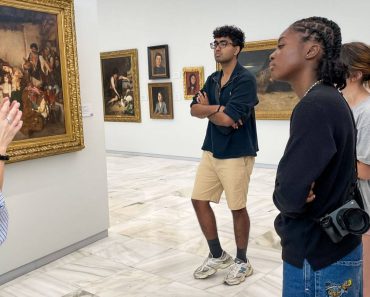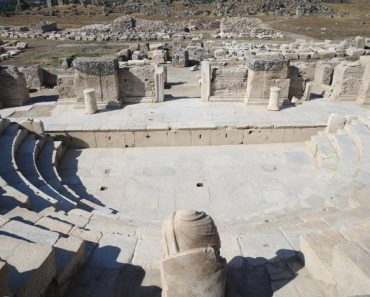Dr. Dimitrios Kouroupis is an Assistant Professor in the Orthopedics Department, University of Miami, principal investigator and faculty member with a dual appointment at the Department of Orthopedics – UHealth Sports Medicine Institute and the Diabetes Research Institute & Cell Transplant Center, University of Miami, Miller School of Medicine. He is an expert in MSC biology and their potential clinical applications in regenerative medicine. Throughout his career, he has thoroughly studied various scientific aspects of Cellular Biology and Regenerative Medicine concerning cell-based therapeutic approaches for treating pathological conditions. The development of off-the-shelf novel stem cell therapies and the generation of innovative stem cell-based therapeutic implants are among his major priorities.
The National Herald: Tell us about yourself and your family.
Dr. Dimitrios Kouroupis: I was born and raised in the northern suburbs of Athens, and I am the only child of my parents. My parents heavily influenced my education and career, as both were highly educated and worked as high school teachers in Greek public schools. They were teaching ancient Greek literature and history, so I was exposed to this inductive University-oriented environment from a young age. On the other hand, I was raised in a house with a huge maritime influence, as most other members of my family (grandfather and uncles) were captains in merchant and cruise ships traveling around the world as proper Greek seafarers.

This strong, adventurous, and educated environment formulated my visionary and stubborn-to-succeed character from a young age. It gave me all the vision and strength to achieve my dream, to become a real scientist, discovering novel treatments for humanity. In this ‘Ulysses trip’ as I would characterize it, two other major mentors played crucial roles in my development, in England, Dr. Elena Jones, and in the U.S., Dr. Diego Correa. Both their influences during this scientific adventure resulted in my becoming a professor at an American university. For this, I am proud, as living in this country, I realized that the USA is indeed where dreams can come true, regardless of how big and not feasible they may look at the beginning.
TNH: What is your specialty?
DK: I specialize in Regenerative medicine and tissue engineering approaches to treating various human pathologies, focusing on the musculoskeletal system.
TNH: Share with us your contribution in lay terms to the field of Stem Cell biology.
DK: I am working on how mesenchymal stem cells can repair and heal the body, especially regarding joint pain, arthritis, damaged cartilage, and wounds. Specific topics I am interested in are:
- Healing Joints with Special Fat-Derived Mesenchymal Stem Cells
We discovered that a particular type of stem cell found in the knee’s fat tissue (called the infrapatellar fat pad) is good at calming inflammation and helping repair joint damage, especially in arthritis.
- ‘Training’ Mesenchymal Stem Cells Before Putting Them in the Body
We showed ways to ‘train’ stem cells outside the body, like giving them a workout, so they can better heal tissues like cartilage, tendons, or blood vessels when put into a patient.
- Tiny Healing Bubbles from Mesenchymal Stem Cells
Stem cells naturally release tiny packages (exosomes or extracellular vesicles) that carry healing signals. We have shown that these ‘healing bubbles’ can reduce joint pain and swelling, protect various tissues from damage, and help wounds heal faster (like diabetic foot ulcers). The extracellular vesicles can be used as a drug-like treatment without needing the full cells.
- Pain Relief Without Pills
We discovered that these extracellular vesicles can block the chemicals that cause joint pain, like Substance P and CGRP. This could lead to pain relief for arthritis patients without using opioids or steroids.
- Bone Healing
Earlier in my career, I helped explain how specific stem cells can be used to repair broken or damaged bones, laying the groundwork for future bone therapies.

TNH: What exactly is your research based on?
DK: To date, the therapeutic efficacy of human mesenchymal stem cells has been investigated in various clinical trials with moderate or, in some cases, inconsistent clinical outcomes. The still elusive reproducibility partly relates to constitutive differences in the cell preparation, translated into variable ‘cell potencies’. Other factors include poor cell homing, survival upon infusion in vivo, and age/disease-associated host tissue impairment.
Therefore, my research’s main aim is to advance regenerative medicine by bridging foundational stem cell biology with translational therapeutic strategies. I want to leverage stem cells and their extracellular vesicles to treat musculoskeletal disorders, inflammatory pain, and tissue inflammation.

TNH: Your research on Regenerative Medicine and Tissue Engineering fields has yielded multiple publications.
DK: I think the bullet points below summarize the actual focus of my publications using stem cells and their extracellular vesicles:
- Advanced Stem Cell Manufacturing & 3D Cell Preparation
- Immune System Regulation & Anabolic Effects For Tissue Regeneration
- Cartilage Protection, Osteoarthritis & Joint Regenerative Potential
- Wound Healing
- Bone Repair
TNH: What brought you to the United States?
DK: I came to the U.S. and the University of Miami eight years ago, when Dr. Diego Correa hired me for my second postdoctorate.

TNH: Are Extracellular therapeutics/exosomes the insulin of our era?
DK: Initially believed to be a mechanism for cells to ‘take out the trash’, the latest research in regenerative medicine indicates that extracellular vesicles released by all living cells can unlock many transformative possibilities as markers of disease and successful regenerative medicine therapeutics. But why compare extracellular vesicles to insulin?
Here’s what makes the comparison meaningful in simple terms:
- Extracellular therapeutics are Cellular Messengers on Steroids
Extracellular therapeutics are minute, natural ‘envelopes’ released by cells that can deliver potent therapeutic proteins, genetic information, and signaling molecules to other cells. Think of them as mini-delivery drones shuttling crucial information across the body.
- Potential Across Diseases
Scientists are exploring extracellular therapeutics as biomarkers (tiny indicators) for early disease detection and as therapeutic tools – in heart disease, brain injuries, osteoarthritis, diabetes, and more. The idea is that, like insulin, they could restore balance in malfunctioning systems.
- Natural, Tailorable, and Broad-ranging
Derived from cells, extracellular therapeutics are naturally compatible with the body and can be engineered with specific cargo for different therapeutic purposes
TNH: What is the future for these extracellular therapeutics/exosomes in regenerative medicine?
DK: The future of extracellular therapeutics/exosome-based therapeutics in regenerative medicine is shaping into one of the most exciting frontiers in biomedicine. While still early, their potential is massive, possibly changing how we treat injuries, chronic diseases, and even aging.

Here’s what the future likely holds:
- Cell-Free Regenerative Therapies
Instead of injecting stem cells, doctors may soon inject extracellular vesicles – the small ‘messenger bubbles’ those cells naturally release – to trigger healing without the risks of full cell transplantation.
Potential Benefits:
– No risk of unwanted immune reactions or tumor growth
– Easier to store, standardize, and deliver (like a drug)
– Faster regulatory approval than cell-based therapies
- Precision Repair for Specific Tissues
Extracellular vesicles can be tailored to carry specific instructions, depending on the damaged tissue – brain, heart, cartilage, tendons, or skin.
For example:
– In arthritis treatment: extracellular vesicles that reduce joint inflammation and rebuild cartilage
– In heart repair: extracellular vesicles that signal heart tissue to regenerate after a heart attack
– In spinal cord injuries, extracellular vesicles help rebuild nerve pathways or reduce scar tissue
- Off-the-Shelf Therapeutics
Because extracellular vesicles can be mass-produced and stored, future regenerative treatments may resemble common drugs – ready-to-use kits instead of complex surgeries or personalized stem cell procedures.
- Smart Delivery Systems
Extracellular vesicles can be engineered like precision-guided missiles:
– Loaded with specific genes, RNAs, or proteins
– Coated with ‘GPS’ molecules to target exact locations (e.g., a worn-out knee joint or an inflamed pancreas)
This could make regenerative medicine far more targeted and efficient, reducing side effects.
- Challenges to Overcome First
Despite the promise, real clinical use still faces key hurdles related to:
– Manufacturing consistency: Hard to produce high volumes of Extracellular vesicles with reliable quality
– Storage & stability: Keeping them active over time is tricky
– Delivery methods: Ensuring they get to the right tissue and don’t get cleared too quickly
– Regulation: Still a gray zone for the FDA and global agencies.







